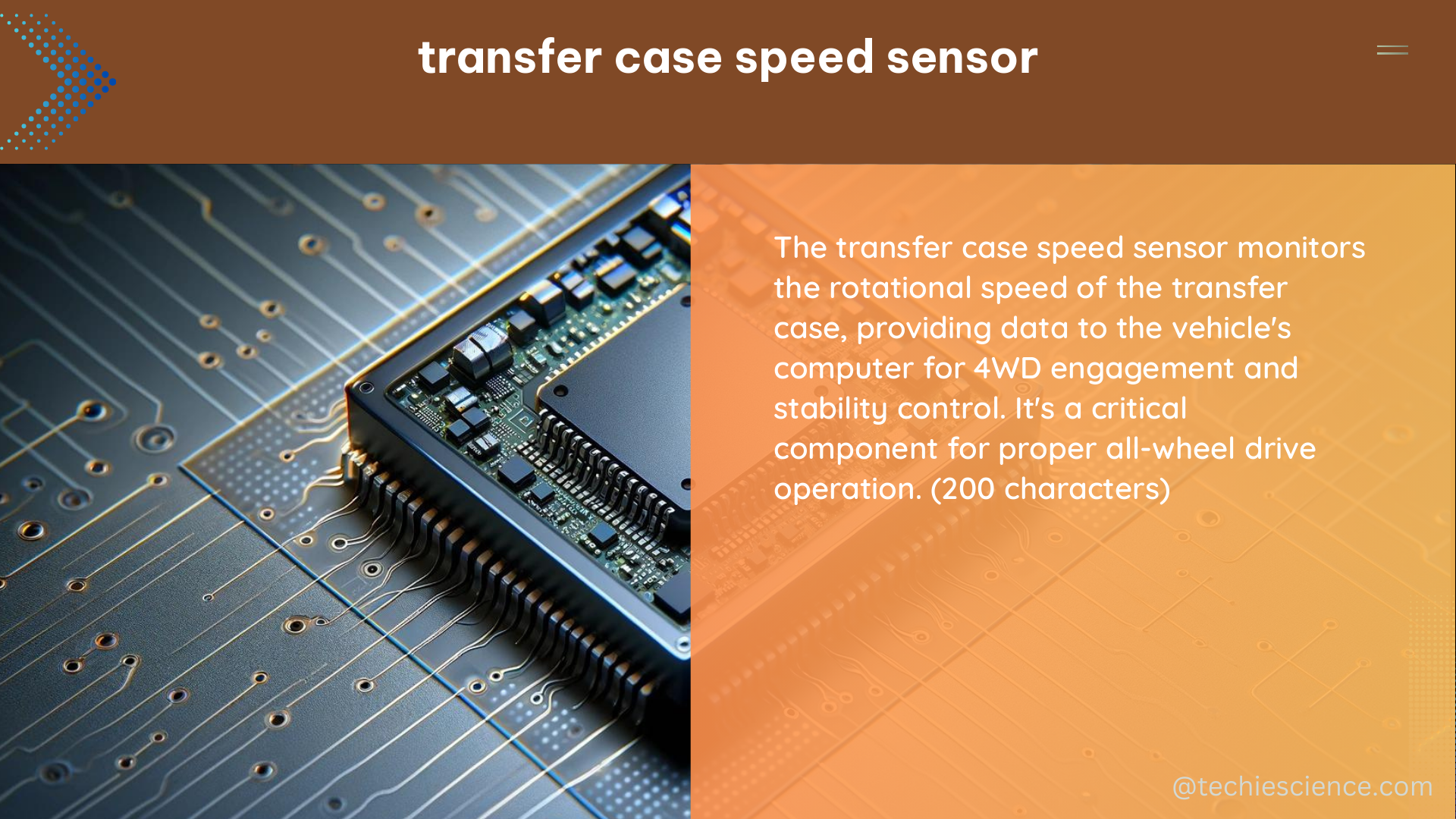The transfer case speed sensor, also known as the vehicle speed sensor (VSS), is a crucial component in modern vehicles, particularly those with four-wheel drive or all-wheel drive systems. It measures the rotation speed of the transfer case output shaft, providing valuable data to the vehicle’s powertrain control module (PCM) for various functions such as gear selection, speedometer operation, and traction control.
Technical Specifications of Transfer Case Speed Sensor
The transfer case speed sensor is typically a Hall effect sensor, generating a square wave signal with a specific pulse rate. This pulse rate varies depending on the vehicle make and model, but it usually ranges between 16 and 40 pulses per revolution (PPR). For instance, the NP241 transfer case in some Ford and GM vehicles has a pulse rate of 40 PPR. This information is essential when swapping or upgrading transfer cases, as the pulse rate must match the PCM’s expectations to ensure proper operation.
Pulse Rate Variations
| Vehicle Make | Transfer Case Model | Pulse Rate (PPR) |
|---|---|---|
| Ford | NP241 | 40 |
| GM | NP241 | 40 |
| Jeep | NP231 | 32 |
| Toyota | T-Case | 24 |
| Nissan | R230 | 16 |
It’s crucial to note that the pulse rate can vary significantly between different vehicle makes and models, even for the same transfer case model. Accurately identifying the pulse rate of the original sensor is essential when replacing or upgrading the transfer case speed sensor.
Diagnosing and Testing the Transfer Case Speed Sensor

To test a transfer case speed sensor, you can use a multimeter to check the resistance between the sensor’s terminals. The specific resistance values can vary depending on the vehicle, but a general guideline is as follows:
- Locate the transfer case speed sensor, which is typically mounted on the transfer case housing.
- Disconnect the sensor’s electrical connector.
- Use a multimeter to measure the resistance between the sensor’s terminals.
- For a Hall effect sensor, the resistance should typically be between 800 and 2,000 ohms.
- If the resistance is outside this range or the sensor is not providing a signal, the sensor may need to be replaced.
Example: 2009 Ford Expedition
On a 2009 Ford Expedition, the transfer case speed sensor has the following terminal configuration:
- Terminal 2: Ground
- Terminal 6: Signal
If the resistance between terminals 2 and 6 is less than 10,000 ohms, the rear Hall effect sensor should be replaced, and the diagnostic trouble codes (DTCs) must be cleared.
Upgrading or Swapping Transfer Cases
When upgrading or swapping transfer cases, it’s crucial to ensure that the pulse rate of the new VSS matches the original one. If the pulse rates don’t match, the PCM may not operate correctly, leading to issues with gear selection, speedometer operation, and traction control.
To ensure a successful transfer case swap or upgrade:
- Identify the pulse rate of the original transfer case speed sensor.
- Verify that the replacement transfer case speed sensor has the same pulse rate.
- If the pulse rates don’t match, you may need to reprogram the PCM or install a compatible sensor to ensure proper operation.
Failing to match the pulse rate can result in various problems, such as:
- Inaccurate speedometer readings
- Improper gear selection
- Traction control system malfunctions
- Diagnostic trouble codes (DTCs) related to the speed sensor
Conclusion
The transfer case speed sensor is a critical component in modern four-wheel drive and all-wheel drive vehicles. Understanding its technical specifications, testing procedures, and the importance of matching pulse rates during upgrades or swaps is essential for maintaining the proper operation of your vehicle’s powertrain and related systems. By following the guidelines and best practices outlined in this comprehensive guide, you can ensure your transfer case speed sensor is functioning correctly and avoid potential issues down the road.
References
- How to Test Transfer Case Speed Sensors on a Ford Expedition
- Transfer Case Speed Sensor
- Transfer Case Speed Sensor Troubleshooting
- Speed Sensors and VSS for Transfer Cases

The lambdageeks.com Core SME Team is a group of experienced subject matter experts from diverse scientific and technical fields including Physics, Chemistry, Technology,Electronics & Electrical Engineering, Automotive, Mechanical Engineering. Our team collaborates to create high-quality, well-researched articles on a wide range of science and technology topics for the lambdageeks.com website.
All Our Senior SME are having more than 7 Years of experience in the respective fields . They are either Working Industry Professionals or assocaited With different Universities. Refer Our Authors Page to get to know About our Core SMEs.